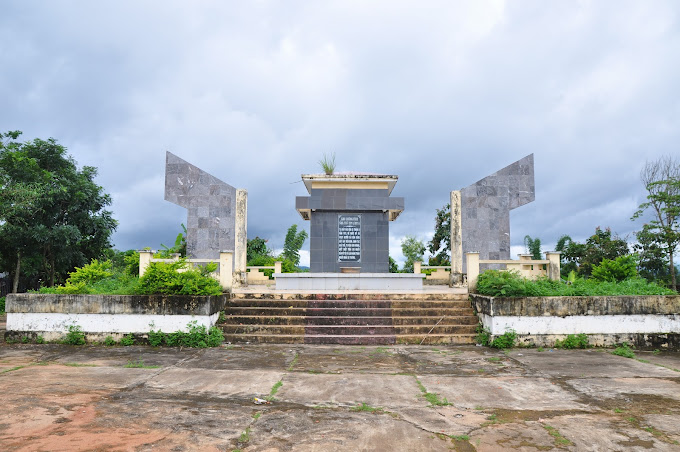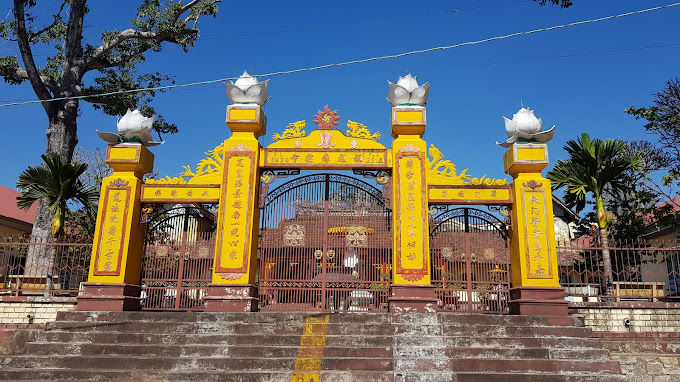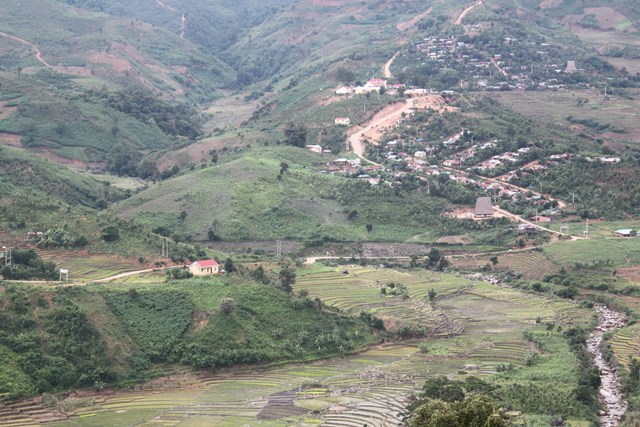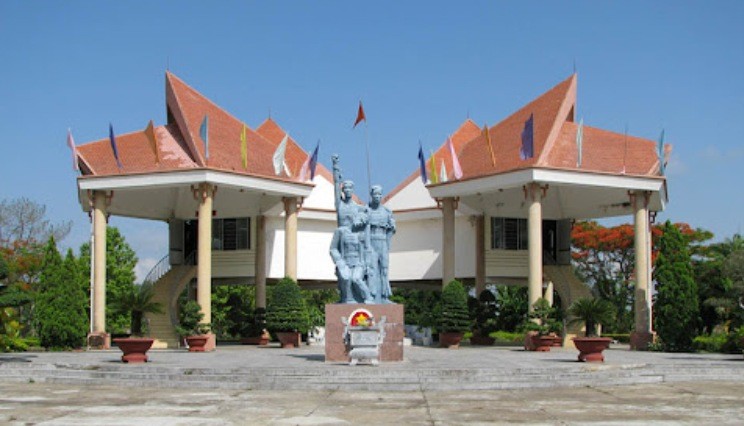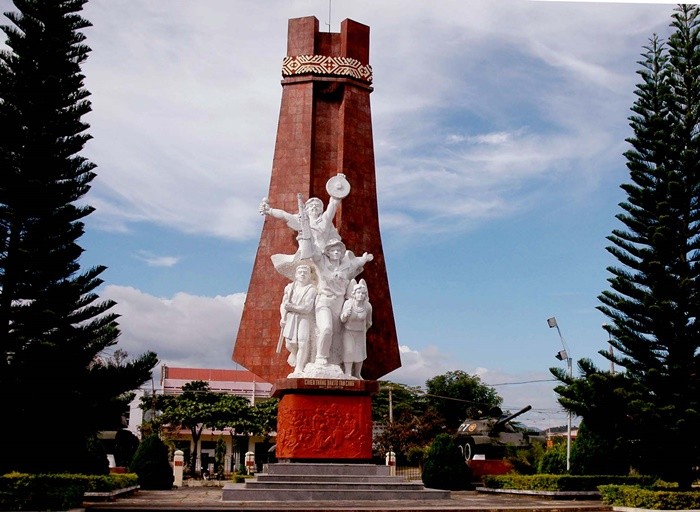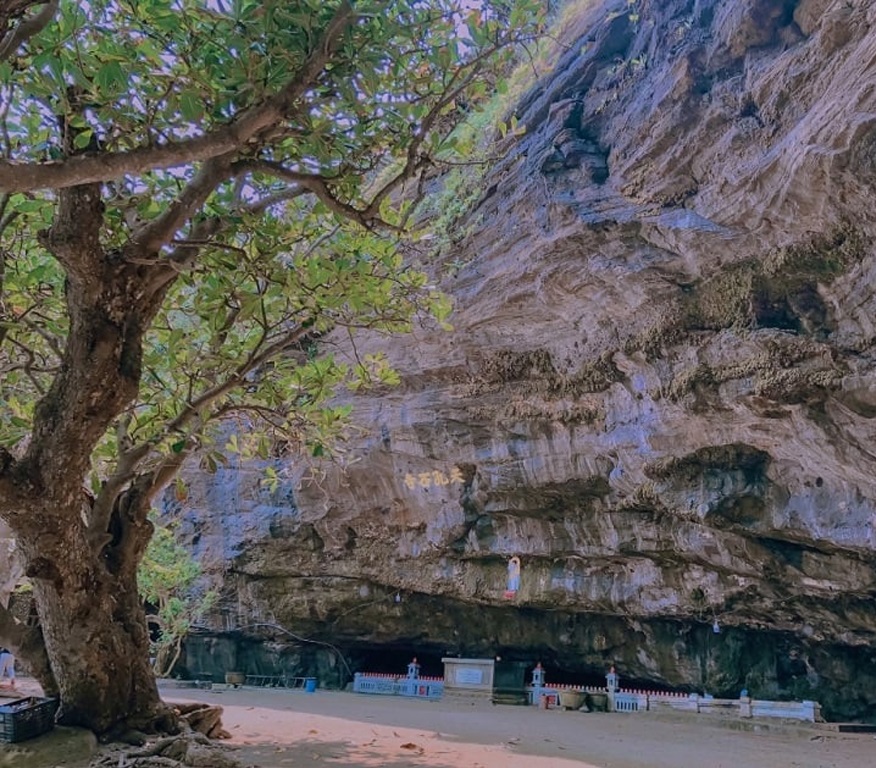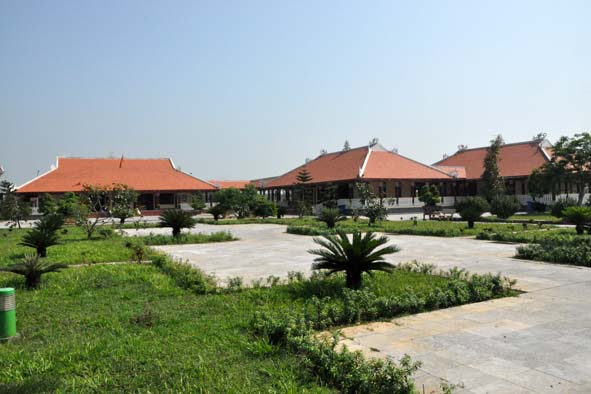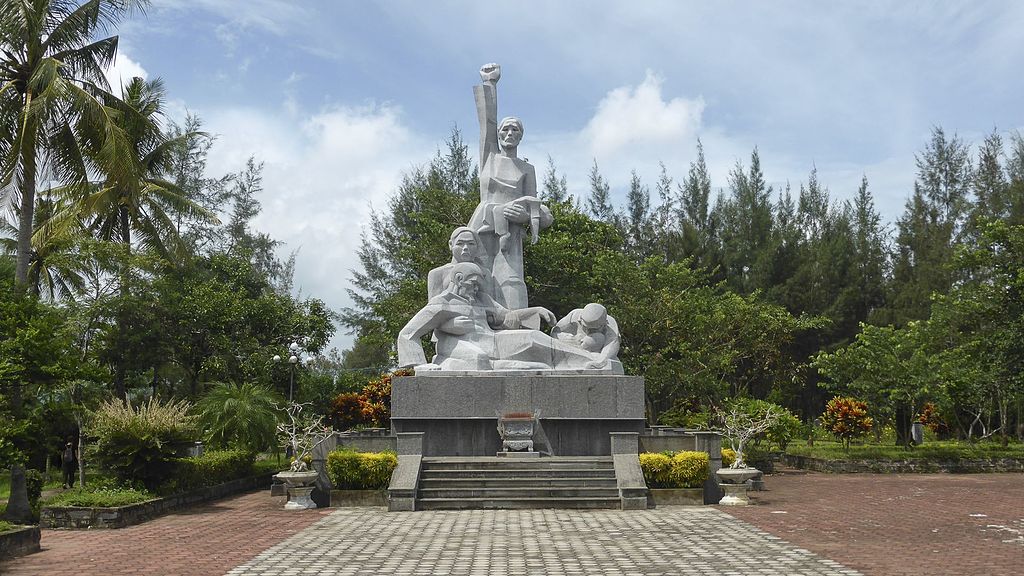Relic point Vietnam
Việt NamKon Hrinh evidence area
The evidence area of Kon Ho ring Church in Kon Ho ring village, Dien Binh commune, Dak To district, Kon Tum province is a place that marks the crimes of the American imperialists and the Saigon puppet government. Here, on the night of May 25, 1972, the US imperialists and the Saigon puppet government used planes to bomb and bomb the Kon Ho ring church and monastery, killing 500 innocent people and killing hundreds more. injured. More than 10 years ago, to commemorate the people who died due to the crimes of the American imperialists and the Saigon puppet government, Kon Tum province invested in building the Kon Ho ring Church relic area. The project is solidly built, with many main items such as: Memorial stele with content reflecting the crimes of the enemy, green campus, fence... After completion, the Kon Church Relics Area Ho ring has become a destination for local people as well as tourists inside and outside the province. Kon Ho ring Church is an outstanding religious architectural work in Dien Binh Commune, Dak To District, Kon Tum Province. Built in 1959, this church is the gathering place of the K'ho community, an ethnic minority living mainly in Kon Tum. Kon Ho ring Church stands out with its unique architecture, inspired by the traditional culture of the K'ho ethnic group. The temple roofs are made from bamboo and coconut leaves, creating a wild, rustic beauty that is no less impressive. Inside the church, paintings and statues of saints are carved on wood, creating a sacred and solemn atmosphere. Kon Ho ring Church is not only a gathering place for religious ceremonies but also a place to attract tourists and those who love culture and architecture. Visitors coming here will be able to visit, learn about the culture and history of the K'ho ethnic group and also have the opportunity to experience their life. In addition, Kon Ho ring Church is also a place where you can learn about the spiritual life of local people, as well as participate in religious activities such as festivals, seminars, and learn about ethics and lifestyle. nation's life. With its beauty and special historical and cultural value, Kon Ho ring Church has become a tourist destination not to be missed when you come to Kon Tum. Take time to explore and experience the feeling of peace and quiet at this location. Surely you will have memorable and meaningful experiences when you come to Kon Ho ring Church. Source: Kon Tum province information portal
Quang Ngai 4318 view
Bac Ai Pagoda
Bac Ai Ancestral Pagoda is located on Mac Dinh Chi street, Quyet Thang ward, Kon Tum city. The pagoda was built in the 8th year of Bao Dai (ie 1932 to 1933). Located on a high ground, the pagoda faces south, following Hue architectural style, Mon-shaped, including the Main Hall, Dong Lang, Tay Lang and Three Entrance Gate. Leader Vo Chuan, designed and urged both Kinh people and ethnic minorities to explore the jungle hill to build a pagoda, designed in the style of the word "Mon". In the year of the Goat, 1931, the Central provinces suffered consecutive droughts and crop failures, and people were hungry. Therefore, in the late years of 1931 and 1932, immigrants from the provinces of Hue, Da Nang, Quang Nam, Quang Ngai, and Binh Dinh flocked to the highlands and Kon Tum. During this migration, 70% died of starvation along the way, the remaining 30% reached the promised land. They cleared the forest for farming, but in this place they encountered many unforeseen things: wild animals, raging cobras biting countless people to death, people were confused and scared, night and night in this land, things happened. Many scary phenomena occurred. In 1932, Director Vo Chuan invited Mr. Hoang Thong, head of Bach Sa Pagoda, Quy Nhon, and the monks to go to Kon Tum to fast for 3 days to pray for the souls of unjustly deceased people. After the funeral ceremony, Mr. Vo Chuan asked Mr. Hoang Thong to prove his name Bac Ai. Charity is immense love, regardless of religion, Kinh people or Upper people. The pagoda was given the sign "The Four Bac Ai Tu" by King Bao Dai in 1933. In 1990, the pagoda was restored with the organization of the Venerable Abbot Thich Chanh Quang. Looking at the overall architecture, Bac Ai Patriarch Pagoda was built in the North-South direction, in Mon style, opening for that direction is the three-entrance gate, leading to the main hall in the center and the left and right sides are Dong Lang and Dong Lang. Tay Lang. The main hall consists of 3 rooms and 2 wings. The ancient building is divided into 3 compartments: front hall, middle hall, and upper hall. The roof is tiled, the brick walls are whitewashed, and the ceiling is covered with ceilings. The rafters, rafters, and columns all use precious woods such as purple star, rosewood, and redwood, elaborately and elaborately carved by Hue artisans. This space worships Tam The Buddha, Amitabha Tam Ton, Hoa Nghiem Tam Thanh... In particular, there is a stele recording the merits of French Captain Quenin and a wooden pillar symbolizing the 7 skulls of a Japanese officer who committed suicide at the pagoda yard at the end of World War II. Outside the main hall is Hoa Vien, where tombstones, towers, and shrines worship the God Emperor Bon Canh, Mountain God, Doan Quan and tru house are concentrated. Through many restorations, Bac Ai Ancestral Pagoda's original architectural features have been changed, and some unique sculptures such as flanking dragons and winding ropes are no longer there. The system of worship statues is covered with a layer of bright bronze, unable to retain its pristine beauty. However, a number of precious artifacts with visual artistic value such as the Statue of the Three Holy Mother Goddesses, the Guan Yin statue made of cracked ceramic, the Hoang Phi, the Couplet, the Ordination box, the Seal, etc. are still on display. subtle traces of time. Currently, Bac Ai Ancestral Pagoda is one of three communal houses (Vo Lam Communal House, Trung Luong Communal House, Bac Ai Ancestral Temple) that have been recognized by the People's Committee of Kon Tum Province as a historical-cultural relic. provincial level Source: Kon Tum Tourism
Quang Ngai 4664 view
Plei Kan victory
Plei Kan is located in Ngoc Hoi district, Kon Tum province. It is located in the north of Kon Tum province, on the eastern slope of the Truong Son range. A special feature of Plei Kan is that it is located at the crossroads of three countries: Vietnam, Laos and Cambodia. Plei Kan has an important history during the Vietnam War. Before 1965, Plei Kan was a large village of the Xe Dang ethnic group and other ethnic groups such as Brau, H Lang, and Kdong. Its strategic geographical position was recognized at the end of 1964 when the US decided to build a cluster of military bases here. Plei Kan in the language of the Xe Dang people is "big village". Before 1965, this was a place where the Xe Dang and Brau people lived in harmony in a peaceful village at the cross-border area of the three countries Vietnam - Laos - Cambodia. At the end of 1964, realizing the important strategic position at the Indochina border junction, the US puppet implemented a policy of gathering people to set up hamlets to isolate the people from the revolutionary forces, herding people to Dak Rnang village (Tan Canh, Dak To) established a strategic hamlet. In 1966, the US built Plei Kan into a military base located in the Indochina junction area (we often call it Plei Kan Base) to block the attack of our main army from the North and from Laos and Cambodia. The entire base has areas A, B, C, D, E, arranged continuously on 5 hills separated by 600 - 1,000 meters. In particular, area A is the central area. There is a tank detachment, a military airport, a field airport, 155mm and 105mm artillery positions, a system of underground bunkers, bunkers, hospitals, warehouses... The base is surrounded by 8 to 12 layers of barbed wire. Since 1969, here, there have been regularly 450 - 500 border rangers (95th Border Ranger Battalion) and 2 artillery companies of E 42 (Division 22) of the puppet regime. In early October 1972, the Central Highlands Front Command assigned the 10th Division the task of destroying Plei Kan Base. The 66th Regiment, the 37th Special Forces Battalion and most of the Division's artillery were ordered to attack. At 10:00 a.m. on October 12, 1972, from the surrounding artillery positions, our artillery continuously opened fire. All types of D74, 105mm, 155mm DKZ, B72 artillery, 106mm mortars... simultaneously bombarded targets in the base. Under the support of infantry, artillery and special forces, they cut the fence and opened the door. At 11:00 a.m., with strong support from artillery, tanks and infantry, we heroically rushed forward to capture the targets. The fighting in the base was extremely fierce. We and the enemy fought over each bunker, bunker, fortification... With a brave and tenacious spirit, after nearly a day and night of fighting, by dawn on October 13, 1972, we had complete control of Plei Base. Kan. As a result, we killed 404 enemies, captured 65, shot down and destroyed 6 aircraft, captured 6 105mm guns, 2 155mm guns, 4 tanks and the entire ammunition warehouse. With the victory at Plei Kan Base, we have completed the liberated area north of Kon Tum, opened the Indochina border corridor, and our strategic transportation route from the great rear of the North to support the battlefield. The South via the Ho Chi Minh Trail became a solid continuous system and liberated tens of thousands of people. Today, the Plei Kan victory relic site is located on the Ho Chi Minh Highway, in Dak Xu commune (Ngoc Hoi district). Plei Kan Victory Historical Relic was ranked at National level on May 15, 2024. Source: Kon Tum province electronic information portal
Quang Ngai 4852 view
Kon Tum Provincial Party Committee Base relic area
The revolutionary historical relic area of Kon Tum Provincial Party Committee Base is located in the Northeast of Mang Ri commune, Tu Mo Rong district, Kon Tum province. It is one of the bases with a very important position and strategic role in the resistance war against the US to save the country of Kon Tum Province in particular and the Central Highlands in general. The base was built, consolidated and developed in a very favorable area. located in the revolutionary heart of the Xo Dang ethnic population. This place has a very complicated divided terrain, with a continuous system of hills and mountains located in the Ngoc Linh mountain complex, with high mountains and extremely dangerous deep streams, making it very difficult for the enemy to detect. attack us. But on the contrary, this is a very convenient area for us in terms of communication system, located at the northern tip of the Central Highlands, the gateway connecting to the Socialist North, where our bases and basic areas are adjacent. from all directions in the province. On that basis, it creates favorable conditions for us in the process of moving as well as in the process of attacking or retreating to defend. Because of such favorable conditions, the Provincial Party Committee stood up to operate and direct the struggle during the period from 1960 to 1972. In early 1955, the Kon Tum Provincial Personnel Committee moved to Kon Po Oai and Kon Po E (Po E commune), then moved to Dak So Lo and then moved back to Nuoc Che (now in Ngoc Tem commune, Kon Plong district), stabilize the organization and direction, and urgently promote the shift in ideology and organization to suit the new situation. At the end of 1959, the Kon Tum Provincial Party Committee moved its agency to H80 (now Tu Mo Rong district) located in Mo Gia village, Mang Ri commune to promptly direct the struggle movement in the coming period. Because the terrain H29 (Kon Plong) is remote, the direction is difficult and timely. So the Kon Tum Provincial People's Committee chose the location at Dak Y Hai stream in Mang Ri commune as a base, because this is a strategic military as well as political area, behind the mountain range. Majestic Ngoc Linh Mountain with an altitude of 2598m is located to the north, to the east is the base of the Party Committee of Zone 5. This area creates a convenient traffic corridor for routes from east to west. In addition, this is also a strategic area for agricultural economic development of wet rice cultivation along two streams Dak My (H30) and Dak Posy (H80). There is also a fairly flat valley with good soil. Providing food sources for the Provincial Party Committee's long-term operations. Moreover, the people here are very good, over 70 villages are of the Xo Dang ethnic group, our revolutionary base where no puppets come. To stabilize long-term operations and direction, at the beginning, the Provincial Party Committee built working departments with rudimentary materials such as bamboo, wood... with large areas. The area of each room is 25m to 30m square. In addition, to ensure safety and prevent bombs and bullets when the enemy detects them, the Civil Affairs Committee also equips a system of trenches and shelters surrounding the working area of the Secretary and Deputy Secretary of the Office. Provincial Party Committee room, logistics, cipher department... And are arranged quite methodically in a closed, continuous system stretching from north to south along the hillside at an altitude of 1922.6m located in the heart of two streams. Dak Y Hai stream is large and Dak Y Hai stream is small. Here, the Provincial Party Committee successfully directed 4 Provincial Party Congresses (from the 1st Congress, March 9, 1960 to the 4th Congress, October 26, 1971), setting out important decisions, Directing the army and people of all ethnic groups in Kon Tum province to fight against the Americans and save the country, such as: Deciding on an order to start a march to gain control over the countryside; General offensive and uprising during the Tet Offensive (1968); Dak To - Tan Canh Campaign, moving towards liberating Kon Tum province... In addition, the Provincial Party Committee has mobilized the strength of ethnic groups and people from all walks of life, mobilized the masses, and well implemented core contents with people as the basis. On that basis, during the struggle against the US, people of ethnic groups in the base areas such as Ngoc Lay, Te Xang, Mang Ri... actively participated in all activities. Among them, especially the people of Mang Ri commune contributed 4,000 working days, participating in the fire line, carrying rice and ammunition. People's cadres and armed forces of the commune's militia and guerrillas directly participated in 17 large and small battles, destroying and disintegrating two American and puppet battalions, and destroying many enemy war vehicles. Transported and protected hundreds of officers from above to return safely, received and nurtured many key units of the Province and military zones during the gathering in the commune. Sharpened 5 million spikes and arranged hundreds of spike holes, made homemade weapons to fight the enemy, contributed to the revolution each year 600 baskets of rice, 5,000 wheat stalks, hundreds of buffaloes, cows, pigs, chickens and tons of other food… The Provincial Party Committee Base relic will forever be a red address, a symbol of the revolutionary loyalty of the army and people of Kon Tum province. With that historical significance, the Kon Tum Provincial Party Committee Base Relic (period 1960-1972) in Mang Ri commune, Tu Mo Rong district was ranked a provincial historical relic by the Kon Tum Provincial People's Committee on August 2, 2019. 2007. Source: Kon Tum province electronic information portal
Quang Ngai 4522 view
Dak Glei Prison
Dak Glei Prison belongs to Dak Choong commune, Dak Glei district, Kon Tum province. The Dak Glei Prison historical relic cluster includes three small works: The guard post area, Can An Tri area and the Prison area. The entire relic area is located on hills, surrounded by high mountains, streams, and valleys. Dak Glei Prison was built by the French colonialists in 1932, where Vietnamese revolutionary soldiers were detained in the years 1932 - 1954. At the same time, the colonialists also quarantined influential revolutionary activists. with a plot to control the entire Central Highlands. Initially, Dak Glei prison only detained people who did not submit to the ruling policies of the French colonialists and their henchmen. But since the end of 1939, the French colonialists have turned this place into a place to imprison communist soldiers after intensifying the repression of the revolutionary movement. Not only is it the place where famous revolutionary poets like To Huu were imprisoned, this is also where many key Party figures were arrested such as Nguyen Duy Trinh, Chu Huy Man, Huynh Ngoc Hue, Le Van Hien, Tran Van Tra , Le Ba Tu, Ha Phu Huong and Nguyen Tat Thang. Dak Glei Prison is a rectangular architectural work, consisting of one floor, an area of about 200m2, 19.85m wide, 10.2m deep, including 4 rooms. Located opposite Dak Glei prison through a yard about 20 meters wide is a one-story house with 2 small rooms, also built of stone, the outer room is the guard station, the other is the kitchen. From Dak Glei prison, going down the hillside about 150m is a "solitary prison" about 12m2 wide, built from February to June 1942 right after the escape of two patriotic revolutionaries, To Huu. and Huynh Ngoc Hue. In this prison, the space is both stuffy and gloomy, full of chains and shackles... Located between the prison and the station area is the An Tri prison with rows of prison cells built of bamboo and wood. Each prison has a stall for prisoners to lie down with their heads facing the middle, their feet shackled to the outside, each stall holds about 20 prisoners. In the evening, guards often count feet to check the number of prisoners. Because it was only built of bamboo and unstable wood, the An Tri stretch area currently has no traces of the construction due to differences between recorded documents, and it is impossible to estimate the exact number of 2 or 3. female. Dak Glei Prison is also known by Kon Tum people by another familiar name, To Huu Prison, because during the anti-French period, this was the place where the famous revolutionary and poet To Huu was imprisoned. This place is associated with the spectacular prison escape story of poet To Huu here. Specifically, in early 1942, To Huu and comrade Huynh Ngoc Hue planned to escape from prison. After that event, the French colonialists terrorized other communist soldiers and arrested our people's comrades in An Tri camp and imprisoned them. Today, the relic site has been being restored and renovated, the road system to the relic has also been invested and built smoothly, worthy of being a revolutionary red address, with great educational significance, a A proud symbol of the resilient fighting spirit of revolutionary soldiers. On December 30, 1991, the Ministry of Culture, Sports and Tourism recognized Dak Glei Prison as a National Historical Site. Source: Kon Tum province electronic information portal
Quang Ngai 4573 view
Kon Tum Prison
"Kon Tum Prison" is located at Truong Quang Trong Street, Quyet Thang Ward, Kon Tum City. "Kon Tum Prison" reflects an early historical period of the movement to fight against invaders in our country. Kon Tum Prison was built by the French colonialists from 1905 to the end of 1917. Kon Tum Prison was built next to a large ditch next to the prison on the East-North side of Street 14 (now Phan Dinh Phung Street - Ho Chi Minh Highway running through Kon Tum city); West - South is the green loincloth soldier station; East - South is the embassy, the puppet leader's palace, and the Police Department. They placed Kon Tum Prison under siege and isolation. To facilitate control, they dug a deep trench 150m long, 100m wide, designed four rows of houses in a box shape (square) with an area of about 2.5 hectares, four corners of the prison had 4 bunkers built up, guarded day and night. secure room. The prison is built in the style of the old French fortress Vauban (Vo-ice) of the 17th century. The roof is tiled, the walls are made of whitewashed tocsi, the four sides are not covered by walls like other prisons, four cells are vertical and horizontal. built together into a square, each 18m side has a door and two high huts so the guards can observe inside and outside the prison; In the middle is a small, narrow square yard, the width of a row is 3.5m, of which 2m is laid with planks, 1.5m is a path, people lying on the plank floor can see outside the yard. Kon Tum Prison is a place to detain political prisoners escorted by the French colonialists from Nghe An, Ha Tinh, Thua Thien Hue, and is also a place to provide workers to explore the plateau and open Road 14. According to numbers According to records, this place held about 500 political prisoners and nearly half of them died. Specifically, during the 6-month process of building Road 14, the French colonialists exploited prisoners of war's labor to the point of exhaustion, leading to the death of 210 people in this place. During the years of resistance against the French, Kon Tum prison was considered the most brutal killing place. Kon Tum Prison was once the site of many protests by communist soldiers to protest against forcing prisoners to build roads in Dak Po. Although the protests here were all brutally massacred by the French colonialists, this sacrifice made them admit defeat and was forced to close in 1935. It can be said that Kon Tum prison is proof of this. denouncing the barbaric crimes that the French colonialists committed against our people in the period 1930 - 1931. At the same time, this is also a symbol of the resilience and indomitable struggle to protect the Fatherland of communist soldiers. in Kon Tum land. In 1975, when the war ended, Kon Tum prison became a historical relic of South Vietnam. After the ruins of the war, today only the graves and memorial stele of 8 revolutionary soldiers remain. In 1990, Kon Tum prison was recognized as a national historical and cultural relic site. Source: Kon Tum province electronic information portal
Quang Ngai 4801 view
Dak To victory relic - new scenery
The Dak To - Tan Canh victory shook the entire US-Puppet defense system in the Central Highlands, expanding the liberated area and with the Quang Tri victory, the Southeast region created a new situation in the war. Southern school, contributing to defeating the strategy of "Vietnamization of the war", "Nich Son Doctrine" in Indochina, forcing the US to sign the Paris Agreement to withdraw troops from Vietnam. The Central Highlands is an important strategic area of the region. Among them, Kon Tum is the northern tip of the Central Highlands, located at the intersection of the Vietnam - Laos - Cambodia border; connecting the North - South corridor and the corridor between East and West Truong Son. With this important geopolitical position, the US empire and the Saigon puppet government have concentrated all forces to build the North Kon Tum region into the most solid defense area in the Northern Central Highlands, centered on Dak To - Tan Canh defense cluster. From 1957 to 1972, the US-Puppet built in Dak To - Tan Canh the most solid defense system including base E42 in Tan Canh and base Dak To 2. Therefore, Dak To - Tan Canh The scene became the site of many fierce battles between us and the enemy. In particular, many major campaigns were carried out here such as: Dak To 1 Campaign in 1967, the Central Highlands armed forces destroyed part of the 4th Infantry Division, the 1st Airborne Cavalry Division and The US 173rd Airborne Group at height 875 contributed to the General Offensive and Uprising of Mau Than in 1968, Dak To Campaign 2 in 1969, we destroyed many enemy forces, contributing to defeating the local war strategy. Ministry and the US "search and destroy" plan on the Central Highlands battlefield and especially the 1972 Spring-Summer campaign in the Northern Central Highlands, the focus of which was the liberation of Dak To - Tan Canh. Implementing the guiding policy of the Politburo and the Central Military Commission, our units decided to open the Spring - Summer 1972 campaign with the aim of "Destroying the enemy, liberating Dak To - Tan Canh, if conditions permit, liberate Dak To - Tan Canh". release Kon Tum town. The development direction may be in the direction of Plei Ku; if conditions permit, expand the liberated area west of Plei Ku, liberate Buon Ma Thuot town, forming a complete base connected to the base. Southeast region". Kon Tum Party Committee has mobilized maximum local army forces, guerrillas, and civil servants to coordinate with the main force of B3 and Zone 5 to participate in the campaign. On the enemy's side, the total number of enemy forces deployed in this area amounted to 28 infantry battalions, 6 artillery battalions, 4 armored battalions. The enemy was determined to concentrate their forces to form a solid defense line. prevent the liberation army from taking over the Central Highlands. With the concentration of forces and careful preparation, the two sides created a fierce, fierce battle with complete victory in favor of the liberation army. At exactly 11:00 a.m. on April 24, 1972, the liberation flag given by the Kon Tum Provincial Party Committee to the 66th Regiment on the day of the departure ceremony was carried into battle by our soldiers and fluttered atop the center of the enemy base. , announced the liberation. The Dak To - Tan Canh defense group, which the US and Puppet dubbed the "steel belt" in the Northern Central Highlands, was completely destroyed by our troops. The victory of Dak To - Tan Canh along with the victory of Quang Tri and the Southeast region were campaigns that had extremely important strategic significance. They created a new situation on the Southern battlefield, contributing defeated an important strategic step of "Vietnamization of the war" and "Nich Son Doctrine" in Indochina, forcing the US to sign the Paris Agreement and withdraw troops from Vietnam. With the determination "Truong Son transforms - Po Ko rises up, wipes out the enemy, liberates Dak To", "All for the front line, all to defeat the American invaders", the people of all ethnic groups in the region Kon Tum province has mobilized maximum human and material resources for this campaign. The "revolutionary noodle fields", "liberation noodle fields", "the sound of pestles pounding rice" all night long... providing food for the front lines or the image of a mother "Holding a gun in her hand, carrying her baby in front, carrying bullets on their backs" of the Kon Tum People of all ethnic groups will forever become a noble symbol of the will of all for lives, for national independence and the desire for peace. With profound historical significance, in 2017 "Dak To - Tan Canh Victory Site was recognized by the Prime Minister as a special national relic. Source: Propaganda Department of Kon Tum Provincial Party Committee
Quang Ngai 4700 view
Quang Ngai Cave Pagoda
Hang Pagoda (Thien Khong Thach Pagoda) also has the folk name "Kong Khong Pagoda" located northeast of Re Island (Lon Island) in An Hai commune, Ly Son island district. The unique architecture of Hang Pagoda was not built by human hands but by the magic of creation. Not built of wood, bricks, lime, or mortar, Hang Pagoda is simply a stone cave deep into the foot of Thoi Loi mountain (Ly Son district, Quang Ngai province). Hang Pagoda is the largest natural cave in the cave system in Ly Son, formed during the seaward period, about 4,500 years ago. From the wave marks around the foot of Thoi Loi mountain, rising significantly above the current tide level, especially the rocks in front of Hang Pagoda are vivid evidence of the phenomenon of ocean waves eroding into fine-grained sediment layers. , rocks and carbonate mud. The notes of French archaeologist Parmentier, oral tradition and a few remaining traces show that Hang Pagoda was originally a stone cave that the Cham people used as a place of residence or worship. before the Vietnamese set foot on Ly Son island. The genealogies and legacies of the first families to explore An Hai village show that about 4 centuries ago, during the reign of King Le Kinh Tong, Mr. Tran Cong Thanh and the ancestors of An Hai village were the initiators of this work. renovated and expanded the cave, turning this place into a Buddhist temple. Later, descendants of the Tran family added the spiritual relics of the Zen sages of Ly Hai village to the pagoda to worship. According to the genealogy of the Tran family, the family that oversees Hang Pagoda, this pagoda is about 300 years old. During the time when pirates (Tau O invaders) were harassing, Hang Pagoda was a safe hiding place for people. Inside the pagoda is a cave 24m deep, 20m wide, 3.2m high, and there are many nooks and crannies. Legend has it that in the past, this was the road to the underworld. According to the concept of good and evil going hand in hand, the main space of Hang Pagoda is for the good and those who know how to repent. On the contrary, if the guilty person refuses to turn back, they will be banished to the underworld in a smaller cave next door. Before there was a concrete road running to the top of the slope down to the pagoda, to get to the pagoda, one had to follow the difficult mountainside. The part of the mountainside facing the sea is called the meow, and is where many unfortunate people slip and fall onto the rocks and are injured or even lose their lives. From the foot of Thoi Loi mountain in the Southeast, around the mountain ridge in the Northwest, then following the stone steps down gradually, closer to sea level, visitors will see rows of banyan trees towering in front of the pagoda yard. (square almond tree) is hundreds of years old. Looking up is the windy ocean, looking back is the "heavenly rock cave", looming in the distance is Bo Bai island. In front of the majestic stone pagoda is a full-body statue of Avalokiteśvara Bodhisattva with benevolent eyes facing the ocean as if containing sympathy for sentient beings. Lightly step into the temple, which is also a stone cave, amidst the faint smell of incense, a dim candle shines into the gloomy light and darkness, it takes a moment to calm down, eyes get used to the darkness, to recognize to the altar to worship Tam The Buddha, Amitabha Tam Ton, Hoa Nghiem Tam Thanh and the bodhisattvas, patriarchs, and sages who publicly destroyed An Hai village and Ly Son district. Like all other Buddhist temples, the largest number of people coming to worship and pray to Buddha at Hang Pagoda is on the occasion of Lunar New Year, Nguyen Tieu, Buddha's Birthday, Vu Lan and the days of worshiping, wishing, worshiping Buddha, Bodhisattva... Especially In particular, Ly Son fishermen, whether they are Buddhists or not, come here to worship very solemnly and seriously on Bodhisattva Avalokiteśvara days or before entering the fishing season (sea gate opening). . Source: Vietnam National Tourism Administration
Quang Ngai 4290 view
Memorial house of late Prime Minister Pham Van Dong
Memorial area of Prime Minister Pham Van Dong in Duc Tan commune, Mo Duc district, Quang Ngai. Where many high-ranking delegations from the Party and state, from Quang Ngai province and the people of the country, international friends come to commemorate and learn about Prime Minister Pham Van Dong. Prime Minister Pham Van Dong was born in Thi Pho Nhat village. Since 1925, he participated in the student movement fighting for the French to release Phan Boi Chau, and mourned Phan Chau Trinh. In 1926, he participated in a training course organized by Nguyen Ai Quoc and was admitted to the Vietnam Revolutionary Youth Association. From then on, young man Pham Van Dong embarked on the revolutionary path. The August Revolution was successful and he held the position of Minister of Finance. During the years of resistance against the French, he was a representative of the Party Central Committee and the Government in the South Central region. In 1949, he was appointed Deputy Prime Minister and from September 1954 also served as Foreign Minister and Head of the Central Foreign Affairs Commission. Then from September 1955 to December 1986, he held the position of Prime Minister. Tourists often stop for a long time at the artifacts of the late Prime Minister's daily life. A bike. One suitcase. Coffee box containing rice. Mr. Nguyen Tan Van, Former Vice Chairman of the People's Council of Mo Duc district, Quang Ngai province shared his thoughts: I visited the souvenir area many times, stopped for a long time at the bicycle and the rice cart with 4 food boxes when going. work and was touched by Uncle Ho's simplicity. Prime Minister Pham Van Dong always mingles with the people, sticks with the people, shoulders the burden, and leads the Vietnamese revolution through extremely difficult historical periods. In every position and responsibility, the Prime Minister has completed his duties excellently. During the years of resistance against the French, as a representative of the Party Central Committee and the Government, Pham Van Dong, along with martyrs Huynh Thuc Khang and Nguyen Duy Trinh, directed the fight against the French to maintain the freedom zone of Inter-Region 5. Especially , an extremely astute person in foreign affairs, was the head of the delegation of the Government of the Democratic Republic of Vietnam to the Fontainebleau Conference in France in 1946, and the head of the delegation to the Geneva conference in 1954. Although, busy Busy with national and people's affairs, Prime Minister Pham Van Dong always cares about the young generation and the country's education cause. Educate and cherish the future generations of the country and the nation. During 75 years of revolutionary activities, 41 years as a member of the Party Central Committee, 35 years as a member of the Politburo, 32 years as Prime Minister, 10 years as Advisor to the Party Central Committee, Prime Minister Pham Van Dong has made many great contributions. Prime Minister Pham Van Dong's life is a life of commitment to the revolutionary cause of the Party and the nation. The 115th birthday anniversary of Prime Minister Pham Van Dong is another time to remember and pay tribute to the contributions of the Prime Minister who always lives in the hearts of the people. Source: Quang Ngai province website
Quang Ngai 6382 view
Son My relic site
Son My relic site, located next to Highway 24B, belongs to Tu Cung village, Tinh Khe commune, Son Tinh district, Quang Ngai province. This is a place to preserve evidence of the scene, as well as a place to display images, artifacts and place a monument commemorating the 504 victims of the Son My massacre, also known as the My Lai massacre. Son My is the name the Saigon government gave to Tinh Khe commune, while My Lai is the spelling in military documents and maps, and later in the American press, to designate Tinh Khe commune. This name originates from the name of My Lai village, one of the four villages (hamlets) of Son My. Pinkville (Pink Village) is also another name for Son My used by the US military as a nickname in combat maps. The Son My massacre occurred on March 16, 1968, on February 18, Mau Than year, according to the lunar calendar. The main unit that caused the bloody event that shocked world public opinion was the 1st platoon, 11th brigade, Army division, American expeditionary force. On that "terrible morning", after heavy rounds of artillery shelling the village, American troops landed by helicopter on the fields west of Tu Cung hamlet and Go hamlet (Co Luy hamlet) in Tinh Khe commune. The insanely brutal and destructive massacre began with American soldiers hunting down and shooting civilians. Houses and shelters were destroyed, burned, and cattle were shot and killed. The climax of the brutality was the gathering of villagers, mostly old people, women and children, into groups and then shooting and killing. 102 people were killed at Watchtower, 170 others were shot in a ditch east of Thuan Yen hamlet, Tu Cung hamlet. American soldiers did not encounter any reaction from the "enemy" side, other than the screams of panic and pain from innocent victims. Their only loss in personnel was when black soldier Herbert Carter shot himself in the leg to avoid participating in the massacre of his fellow men. Horrifying truth:. In just one morning, 504 innocent civilians were killed (407 people in Tu Cung village, 97 people in My Hoi village), including 182 women, 173 children, and 60 elderly people. There were 24 families killed, 247 houses burned down. Immediately after the massacre, the National Liberation Front Committee at all levels and the Government of the Democratic Republic of Vietnam spoke out to denounce the crimes of the American expeditionary force before domestic and foreign public opinion. However, it was not until a year and a half later that this horrifying event was revealed in America by American journalists and veterans. Americans and the whole world were shocked. The movement opposing America's involvement in Vietnam spread widely. Many prestigious figures, intellectuals, and social activists in the US and many parts of the world demand that leading figures in the White House and the Pentagon be put on trial for war crimes. After the liberation of the South, the revolutionary government protected the remaining evidence after the massacre, built a memorial for the victims and a house displaying pictures and artifacts related to the Son My massacre. In Thuan Yen hamlet, Tu Cung hamlet, next to the water canal that was once red with the blood of 107 victims who were collectively murdered. After many restorations, the evidence area now has an area of 2.4 hectares, including two main areas: the field evidence area (west) that has been preserved and restored and the additional exhibition area and statues. memorial, reception house (east). In addition, there are relics related to the massacre in Tu Cung village and My Lai village. There are documentary films recording the stories and images of survivors, and many scrapbooks that visitors have written in in many languages, truly expressing the feelings and attitudes of many people. people, of many generations, many different religions, ethnicities and political trends, when learning firsthand about the Son My massacre. Source: Quang Ngai Electronic Newspaper
Quang Ngai 5916 view
